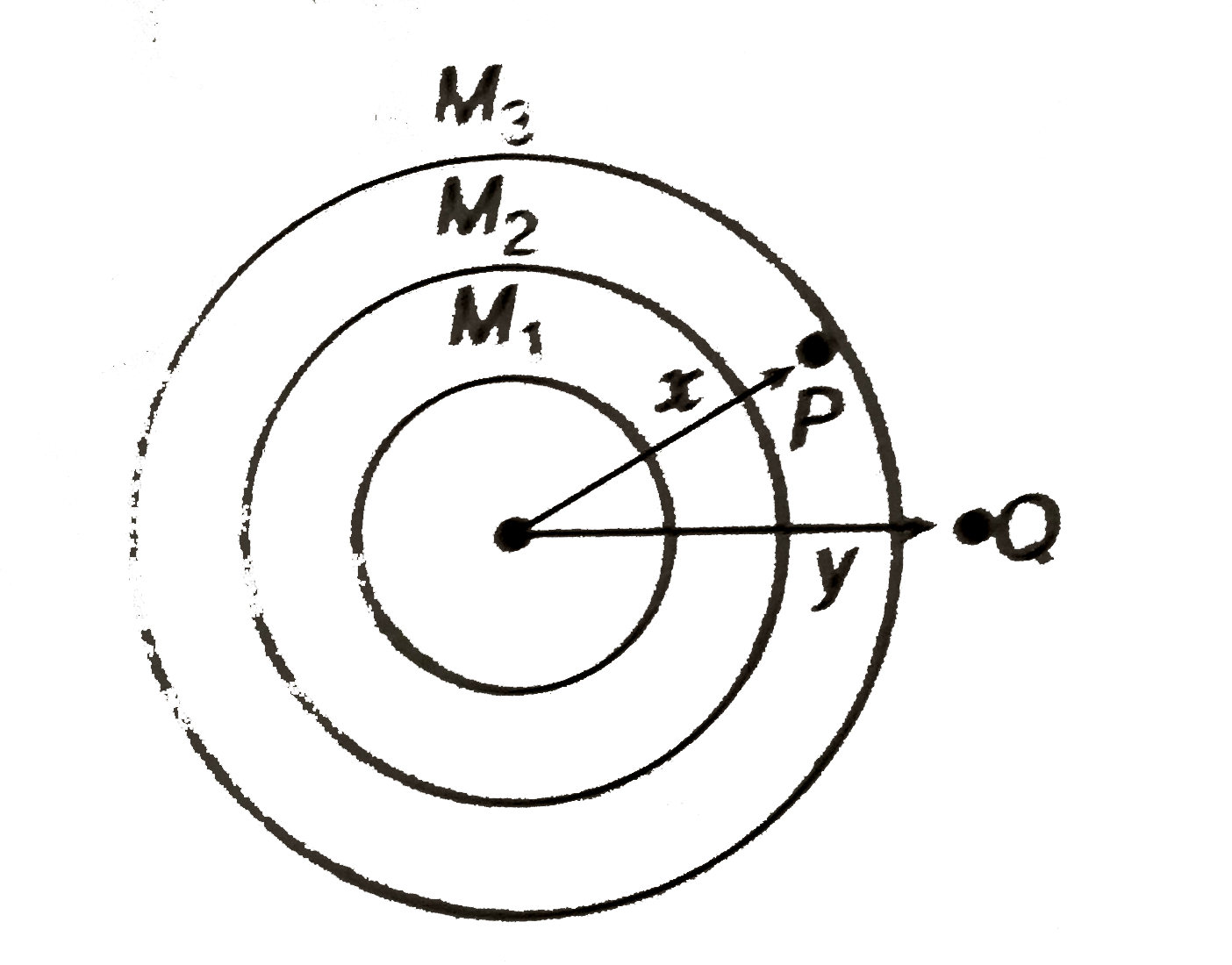Two particles of masses are placed along the x and y axes respectively at a distance from the origin. Calculate the gravitational field at a point P shown in figure below.
 Solution in Tamil
Solution in Tamil
Gravitational field due to at a point .P. is given by
Gravitational field due to at a point .P. is given by
The direction of the total gravitational field is determined by the relative value of
When ,
( as vectors obeys communtation law )
points towards the origin of the co - ordinate system and the magnitude of gravitational field is ,

Topper's Solved these Questions
- BOOK - FULL MARKSCHAPTER - GRAVITATIONEXERCISE - TEXTUAL EVALUATION SOLVED (I. Multiple Choice Questions)15videos
GRAVITATION
- BOOK - FULL MARKSCHAPTER - GRAVITATIONEXERCISE - TEXTUAL EVALUATION SOLVED (II. Short Answer Questions)15videos
GRAVITATION
- BOOK - FULL MARKSCHAPTER - EXAMINATION QUESTION PAPER MARCH 2019EXERCISE - PART-IV10videos
EXAMINATION QUESTION PAPER MARCH 2019
- BOOK - FULL MARKSCHAPTER - HEAT AND THERMODYNAMICSEXERCISE - ADDITIONAL QUESTIONS SOLVED (Numerical Problems)16videos
HEAT AND THERMODYNAMICS
Similar Questions
The linear momentum and position vector of the planet is perpendicular to each other at
04:48View SolutionState Kepler's three laws.
02:20View SolutionThe force F acting on a body moving in a circular path depends on mass of the body (m) velocity(v) and radius (r) of the circular path. Obtain the expression for the force by dimensional analysis method (k=1)
03:54View SolutionThe length of a metal wire is l1 when the tension in it is T1 and is l2 when the tension is T2. The natural length of the wire is:
03:16View SolutionTwo concentric shells of masses M_(1) and M_(2) are concentric as shown. Calculate the gravitational force on m due to M_(1) at points P,Q and R .
06:19View SolutionThe figure represents two concentric shells of radii R_(1) and R_(2) and masses M_(1) and M_(2) respectively. The gravitational field intensity at the point A at distance a (R_(1) lt a lt R_(2)) is
03:46View SolutionTwo bodies of masses M_(1) and M_(2) , are placed at a distance R apart. Then at the position where the gravitational field due to them is zero, the gravitational potential is
03:07View SolutionConsider three concentric shells of masses M1,M2andM3 having radii a,b and c respectively are situated as shown in

Gravitational field at a point located at Q and P is05:47View SolutionTwo stationary particles of masses M1 and M2 are 'd' distance apart. A third particle lying on the line joining the particles, experiences no resultant gravitational force. What is the distance of this particle from M1 ?
01:58View SolutionTwo concentric spherical shells of masses and radii m_(1), r_(1) and m_(2), r_(2) respectively are as shown. The gravitational field intensity at point P is
02:55View SolutionParticles of masses m_(1) and m_(2) are at a fixed distance apart. If the gravitational field strength at m_(1) and m_(2) are vecI_(1) and vecI_(2) respectively. Then
View SolutionCalculate, the gravitational field at point O due to three masses m_(1),m_(2) and m_(3) whose positions are given by the following figure. If the masses m_(1) and m_(2) are equal what is the change in gravitational field at the point O?
View SolutionThe centre of mass of a system of two particles of masses m_(1) and m_(2) is at a distance d_(1) from m_(1) and at a distance d_(2) from mass m_(2) such
View SolutionThe distance between two particles of masses m1andm2 is r. If the distance of these particles from the centre of mass of the system are r1andr2 respectively, then show that r1=r(m2m1+m2)andr2=r(m1m1+m2)
03:13View SolutionParticles of masses m1 and m2 are at a fixed distance apart. If the gravitational field strength at m1 and m2 are →I1 and →I2 respectively.
03:22View SolutionParticles of masses m_(1) and m_(2) are at a fixed distance apart. If the gravitational field strength at m_(1) and m_(2) are vec(I_(1)) and vec(I_(2)) respectively.
02:21View Solution
